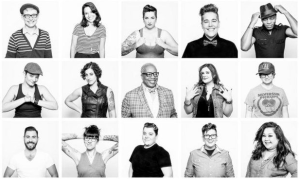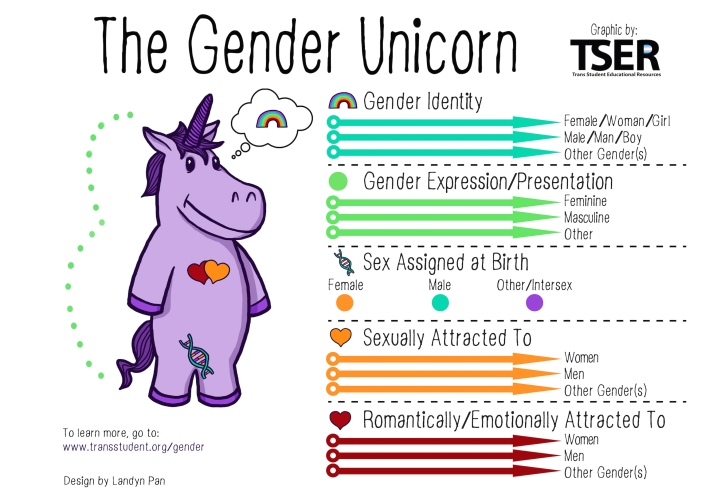
Source: The Identity Project
Originally published on Neutrois Nonsense and republished here with their permission.
Figuring out your gender is a very personal process; only you have the “magic” answers to your own identity.
It can be especially difficult if you feel your gender is non-binary, because there is no template for you to follow. This isn’t to say there aren’t some nifty tools to add to your toolbox (or fresh ingredients to your recipe, or whatever other non-macho allegory you wish to employ) making it easier for you to build your identity.
Through the years I’ve gathered snippets of wisdom – advice which seems obvious in retrospect, but is easily overlooked when you’re in the thick of fighting the binary.
I also feature voices of other gender warriors who share insights on what would’ve helped them along the way, expanding upon the previous What’s My Gender guide.
So, I present: The Gender Playbook: A Guide to Figuring Out Your Gender.
It’s perhaps the most useless set of guidelines because, at the end of it, you still won’t have all the solutions. In fact, you may not have any solutions at all! And I warn you, it is a little long, just like your journey.
I hope it helps set you on a path towards figuring out your gender, finding peace within it.
1. Certain Uncertainty: Your Experience Is Not Unheard Of
Everybody starts somewhere, and the beginning looks different for each person. You may have barely begun questioning gender in a conscious way, or have been grappling with it for decades.
Yet somehow, you’ve arrived at a boiling point where you can no longer brush off these feelings as irrelevant, inconvenient, transitory.
This first step is perhaps the hardest and most important: It marks a stage of exploration, filled with endless rabbit-hole research only to find answers that lead to more questions.
I want you to know that it’s completely natural to feel insecure about these feelings, both what they mean and of having them in the first place.
You are not only diving deep into what it means to be you, but having a non-binary gender (or just considering the possibility) means coloring way outside the lines of what exists in society, sometimes even coloring off the page entirely! So of course it can be both a very scary and exhilarating experience.
2. Labels: Don’t Cling to Them Like Saran Wrap
If a label works, use it. If it doesn’t, don’t.
If a term, label, or concept resonates with you for whatever reason, it usually means you’re on to something.
But don’t let attachments to a particular word, concept, identity, or community dictate who you are, or who you want to become.
When I first saw the word ‘non-binary,’ it really struck me because instead of trying to pinpoint what I was, it captured the one thing I knew at that time – what I wasn’t. I felt comforted that, while I wasn’t sure how to define my gender just then, I was pretty sure that it didn’t lie within the parameters of ‘man’ and ‘woman.'”
Just as you are careful not to tick off boxes prematurely, you shouldn’t be afraid to say “that label doesn’t work for me anymore.”
It’s like that favorite old t-shirt you used to love because it was oh so soft and fit you perfectly, but now it’s all itchy and shrunken and you’ve just plain outgrown it.
It’s best to neatly fold it in a drawer and keep it for its memories, but don’t wear it in public ever again.
Be open to new possibilities about your feelings, but also about changing the words you use to describe them.
3. Can I Be ___ If ___ ?
Can I identify as agender despite not wanting to transition? Can I be transgender, despite not having the extreme discomfort with my body other people talk about? Can I be genderqueer even if I want to keep my pronouns?
You do not have to “qualify” to claim a label that resonates with your experience. Your identity is yours to decide.
I get it though. There is a deeper question stewing underneath this seemingly superficial dilemma.
How can I call myself ___ without feeling the distress, having the doubts, grappling with the confusion, that other people who call themselves ___ claim to experience? In other words, how can I call myself different without feeling the same as everyone else?
What you’re really asking is for a litmus test to decide whether your situation is valid, real, truthful.
We’ve all been through a period of thinking this was all in our heads, just part of some made up fantasy we conjured up and convinced ourselves was true. We’ve all tried to prove how trans we really are, through words or clothing or needles. And we’ve all fallen short, because there was always someone else out there who seemingly felt more pain, underwent a more extreme transformation.
There is no checklist of behaviors or preferences that will determine whether or not you are transgender, non-binary, genderqueer, none, or all of the above.
While I can’t know whether you really are transgender or just going through a gender adjustment period akin to teenage angst, the very fact that you are having these doubts speaks volumes about the normality of your experience.
4. Crawl the Walk: Baby Steps
Clothing. Hair. Binding. Attraction. Identity. Names. Pronouns. Hormones. Surgery. Whoa!
Feeling unsure about one part of gender doesn’t mean you have to hit a pause button on everything else. When I did finally start hormones, I still hadn’t found my name, and was battling the she/he/they pronoun monsters on the side.
You don’t have to know your gender to transition. It’s enough to realize you feel best presenting a certain way. Categorization can come later – or never! (I’m still feeling my gender out…)”
Ambivalence about what to do next can mean your heart knows what it wants, but your brain needs to catch up.
Sometimes the only way to untangle how we really feel about something is to experience it. There are plenty of small steps you can take that’ll allow you to explore certain aspects of your identity.
Trying something out – like a new name (or nickname), a new pronoun, a new shirt or a new hat, even low dose hormones – can be the nudge that pushes you in the right direction. It can turn an abstract experience of discomfort into concrete validation of “this feels right.”
These sensations are the first of many in your exploration of your identity, as you slowly being to peel off the layers and unlearn everything society has engrained in us regarding the gender binary.
5. In the Moment: Listen
But if something doesn’t go quite how you expected, don’t get hung up on that one experience. You’ll have many moments like these which, over time, will add up to provide some clarity.
Countless times, I braced myself to say/do something then didn’t follow through. I was waiting for that perfect segue then hesitated at the last minute. It simply meant I wasn’t ready. But it didn’t mean I would never be ready.
Sometimes you want to come out to someone, or want wear something different, but you end up chickening out at the last minute. Perhaps you felt uncomfortable with that person, or just tired that day; maybe it didn’t feel authentic enough, it was forced, or it simply wasn’t the right moment.
There will be other moments.
6. Explanations? Make a Statement!
Even though few people are familiar with non-binary gender, you don’t need to provide a long winded compendium filled with footnotes and exhaustive definitions, or feel obligated to justify your reasons.
It’s great if you do, since it gives others a chance to understand what you are going through, answer their questions, and help them support you.
Creating educated allies is a wonderful endeavor. But it’s also not your job.
Not everything, nor everyone, needs an explanation. Especially not about your entire gender identity, why you feel the way you feel, or what you’re going to do about it, if anything.
You are allowed to exist, your life needs no explanation or justification or apology. You are allowed to have emotions, you can be hurt or scared or angry or tired or happy or nervous. You are allowed to be loved, your gender representation shouldn’t dictate how much affection your family, your friends, or you give to you or yourself.”
A sensible approach is to tell others (or yourself) exactly what you need. Don’t sweat the details.
What do you want from yourself? What can other people do to make you feel more comfortable? Focus on what you need, right now at this very moment, versus what you think you may want later, or what others want from you.
I’ve always been very practical. When I changed my name, that’s exactly what I did – no more, no less. I simply told people to start calling me Micah. When they asked why (nobody did), I replied “because I want to.” Even when you legally change your name (or gender), stating “personal reasons” is enough to hold in court.
7. Coming Out: Disclosure Is a Spectrum
Coming out is not as simple as opening your closet door.
It’s an ongoing process that requires plenty of courage: opening up to someone about your innermost private (and often jumbled, confused, sensitive) feelings leaves you vulnerable.
Garnering a support system to help you figure out your gender can be relieving. But depending on the circumstances, it may also be a risk; you may experience rejection, denial, or acceptance.
Coming out simply follows the same rules outlined above: baby steps, listen to the moment, no explanations. While verbalizing your feelings out loud to someone may make them feel more real, coming out doesn’t make your identity more or less legitimate.
8. Making Change
It can’t be a process without change, and a big part of this journey is mental.
You’re learning tons of new information, and re-integrating it into old notions of what it means to be a man or a woman. You’re re-building a world where you’ve never had a chance to be you. It’s like basically writing a science fiction novel from scratch: that’s enough imagination to make anybody’s head hurt!
I flip-flopped nearly every day trying to figure it out, and I wound up wrong (kinda) on the ideas I was flip-flopping on. Just take your time; you’ll get it right eventually; you’ll probably be wrong at first, too; that’s also okay.”
9. Read and Research, Meet and Greet

Read, lots: blogs, forums, books, magazines, journals.
The more you think about it the clearer things will get (eventually), and the more information you have to think with the better armed you are to construct your own conclusions.
Another wonderful option is to attend local support groups. Finding gaggles of non-binary folk is hard enough online, although you may be surprised how many other gender questioning people there are in your near vicinity.
Although nobody’s journey will be exactly the same, finding like-minded folk you can share experiences with is invaluable.
10. Gender and Sexuality: Together or Separate?
So you’ve already questioned – and answered – your sexuality. While you and your partner(s) were redefining masculinity and femininity and breaking down hetero-norms about gendered bodies, you also began to suspect that your gender is not quite what it seems on the surface.
Alternatively, you’ve always been on the straight and narrow; being queer might have never crossed your mind. Welcome to the party! Here, have some rainbow cake.
Okay, let’s not get ahead of ourselves. After all, you’re still not sure about anything, much less all this gender-bender stuff.
Up until now, you may not have realized how much variety the queer spectrum really includes, and that all those odd feelings about yourself might have an explanation after all. Joining the queer revolution could even be a frightening prospect.
Whatever your story, it was through your intimate relationships with other people that you came to learn more about your gender.
Whether it took you days or years or decades to finally open up about this other side of you, there are many different ways to be gay, or lesbian, or bisexual, asexual, pansexual, whatever-sexual, and that doesn’t negate, nor exclude, the gender negotiations you’re grappling with. That’s because gender does not exist in a vacuum; our gender is always being perceived and interpreted by others, in the classroom or the living room or even – yes – in the bedroom.
As for whether one causes the other – that’s a question I don’t concern myself with.
My gender (and sexuality) is what it is, and it doesn’t matter why it is that way.
achonburike said: “[Y]ou don’t have to figure it all out immediately, and if your gender/sexuality changes down the road, that’s fine.”
As you learn more about one side of your identity you will uncover other parts as well. Let them inform each other.
11. Non-Binary: Stepping Stone or Destination?
But you’re afraid to start to looking more… normal. Like an ordinary man or woman, blending into the very binary system you’ve been fighting against.
It’s scary to imagine that your identity might actually shift in the future to one you currently find unappealing. Like the little kid who can never imagine wearing khakis and grown-up shoes, here you are twenty years later, shedding your spiral tie-dye t-shirts and looking like an adult.
Because it’s just that: not right now, not tomorrow, but the (somewhat distant) future.
It can be disheartening to realize that – whether externally or internally – your identity might not align with the one you’ve been so invested in. But it’s almost impossible to predict where your identity will end up after going through the grueling gauntlet that is questioning your gender.
Like labels, you should allow yourself as many layovers and pit stops as you need to get to your where you’re going.
After a period of identifying as genderqueer, many transgender people do eventually realize that trans man or trans woman describes them better.
Conversely, some join our ranks after a seemingly straightforward transition; you smoothly traveled from F to M, or M to F, yet alignment is elusive. Another great many of us are finally finding our voice, strongly uniting in ever-growing communities, sharing resources and encouragement about the unique challenges we face, so we may continue to identify as non-binary for years or decades to come.
There is nothing wrong with any of these. I’m glad to have been of help along the way, whatever your destination ended up being. We’re all still one big family, fighting for rights and recognition to be ourselves.
12. Non-Binary Transition: A Betrayal?
Even if your non-binary gender is firm, taking steps towards transitioning, whether it’s clothes or hormones or surgery or legal gender changes, can feel as if you’re betraying your identity. After all, one more step on the transition train takes you closer towards the traditional binary path, right?
Not really.
I legally changed my gender to male – for a number of reasons – despite never feeling entirely male. I guess it was my way of sticking it to the system: “Legal gender is so silly, even someone who is neither can legally be both.”
Conversely, I have a trans male friend who kept his legal “F” with a similar reason to stick it to the system: “I’m a man, no matter what my documents say.”
Both of us took outward actions that were seemingly contrary to what our gender identities would dictate. But each of us had reasons that honored our individual identities in our own unique way; we each felt this was a necessary step in our transition.
Some people do outwardly transition to look more masculine or feminine, but their inner identity is still non-binary. Similarly, binary trans people sometimes decide not to transition on the typical path, or to look like an average man or woman.
There is no real way to know how someone identifies unless you ask. What’s important is to move forward with what will make you comfortable.
13. Conforming to the Stereotype: You Do You
Even genderqueer now has a typical narrative: female-assigned, thin, white, gorgeously androgynous, slight whiff of pre-teen Justin Bieber.
Forget about those who are male-assigned, fat, people of color, femme, working class, middle age, or just plain different. It’s like nobody else exists that can carry the genderqueer title unless they embody a palatable image for the public.
You may also feel pressure from your community, your peers, or yourself, to lock into the binary. “It’s okay if you’re transgender, as long as you don’t upset others over your appearance” – I’ll bet every single one of you has heard something of the sort.
You’re already going through all this trouble to be You, don’t let others dictate what You looks like.
alphadelilas said: “It is fine to be a trans guy who likes dresses and make-up and it is fine to be a trans woman who likes button downs and combat boots. You don’t need to fit the gender stereotype to be trans.”
Easier said than done.
Despite being hyperaware of the barrage of unrealistic images – even those within our community – we inevitably succumb at one point or another to try to fit in. My own attempts at slideover bangs are one of many blights in my journey.
raincitygenderqueer said: “It’s ok to be non-normative or visibly trans. You don’t have to justify your choices to anyone – all bodies are good bodies.”
Just like you are taking control of your own gender, it’s important to take control of your own narrative, which usually means constructing it against a void of representation.
There is no right or wrong way to be You.
14. Answers: You Can’t Collect Them Them All
Here’s a secret: You’ll never know everything.
You’ll never know everything about the world, about science, about gender, about your body, about yourself.
Taking the next step is not contingent on having a detailed playbook of the next fifty. You have one answer. Or two. Or three. Or you realized you were mistaken about something before. Maybe you even made a big public announcement, and now you want to take it back. All of this is allowed.
There is no Gender Playbook (despite what this claims), only useful resources like this one to help you find your own truth.
15. Time: A Precious Gift
My discovery phase is fuzzy and happened a while ago. In retrospect, every conclusion seems obvious. I often wonder why I didn’t figure things out sooner. I’ve forgotten what the confusion felt like.
However, I am sure that as I began to transition, my identity and its expression were continually evolving, a transformation that occurred in parallel to the discovery process.
That’s what this is: a process, discovery, exploration, transformation.
While there may be critical moments, phrases, books, or people that spark small epiphanies within you, the majority of the process consists of background rumination about what your gender is, what your gender isn’t, and what the heck gender is anyway.
Going through the notes I’m seeing a lot of “X is ok, and Y is ok” so I think it’s worth saying that whatever your journey is…it’s ok. Better than ok, it’s great, whatever your path to finding your gender is, it’s great because it’s something that you got to discover and create and evolve and refine. Now, almost two years in I’m still finding out things about my gender that I could not have known two years ago. And that’s ok.
The number one person you have to be patient with is yourself. You’re still figuring stuff out – whether it’s your gender, how to express it, what consequences this may have, what options to pursue, or simply how to explain it to others – and all that thinking and doing and worrying and acting takes time.
lintilla4eva said: “You have as long as you need to figure it out. Even the rest of your life, if that’s what you need.”
People take their entire life to figure things out! Gender is no different.
***
Now I turn to you, dear queerlings.
What advice do you have for those walking the gender tightrope?
[do_widget id=’text-101′]
Micah is the little awesome writer and transgender advocate behind the blog Neutrois Nonsense, which explores non-binary transition, gender, and finding life wisdom beyond the binary. You can follow them on Twitter, Tumblr, and Facebook @neutrois.
Search our 3000+ articles!
Read our articles about:
Our online racial justice training
Used by hundreds of universities, non-profits, and businesses.
Click to learn more





















